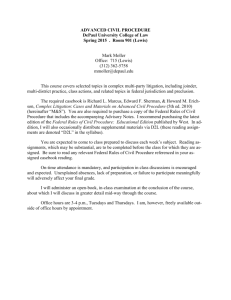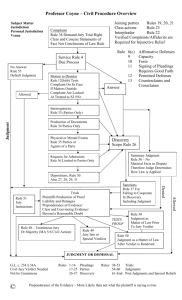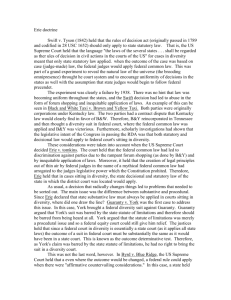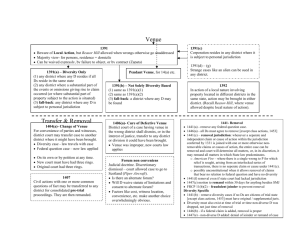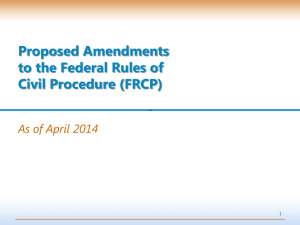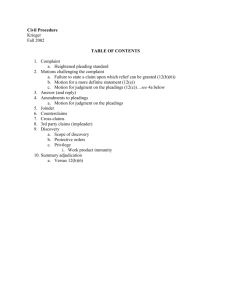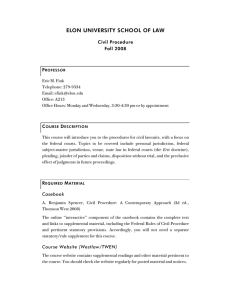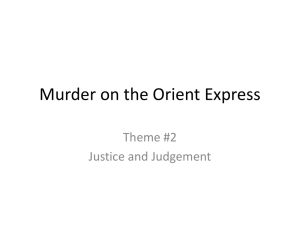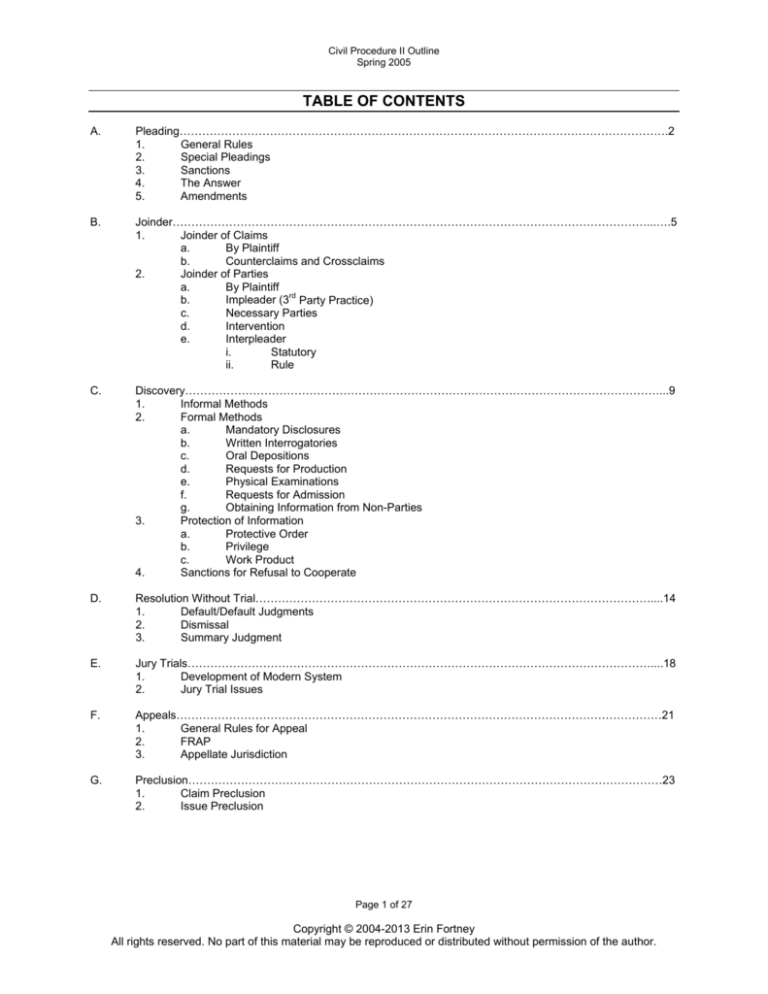
Civil Procedure II Outline
Spring 2005
TABLE OF CONTENTS
A.
Pleading………………………………………………………………………………………………………………….2
1.
General Rules
2.
Special Pleadings
3.
Sanctions
4.
The Answer
5.
Amendments
B.
Joinder………………………………………………………………………………………………………………...….5
1.
Joinder of Claims
a.
By Plaintiff
b.
Counterclaims and Crossclaims
2.
Joinder of Parties
a.
By Plaintiff
b.
Impleader (3rd Party Practice)
c.
Necessary Parties
d.
Intervention
e.
Interpleader
i.
Statutory
ii.
Rule
C.
Discovery………………………………………………………………………………………………………………...9
1.
Informal Methods
2.
Formal Methods
a.
Mandatory Disclosures
b.
Written Interrogatories
c.
Oral Depositions
d.
Requests for Production
e.
Physical Examinations
f.
Requests for Admission
g.
Obtaining Information from Non-Parties
3.
Protection of Information
a.
Protective Order
b.
Privilege
c.
Work Product
4.
Sanctions for Refusal to Cooperate
D.
Resolution Without Trial……………………………………………………………………………………………....14
1.
Default/Default Judgments
2.
Dismissal
3.
Summary Judgment
E.
Jury Trials……………………………………………………………………………………………………………....18
1.
Development of Modern System
2.
Jury Trial Issues
F.
Appeals…………………………………………………………………………………………………………………21
1.
General Rules for Appeal
2.
FRAP
3.
Appellate Jurisdiction
G.
Preclusion………………………………………………………………………………………………………………23
1.
Claim Preclusion
2.
Issue Preclusion
Page 1 of 27
Copyright © 2004-2013 Erin Fortney
All rights reserved. No part of this material may be reproduced or distributed without permission of the author.
Civil Procedure II Outline
Spring 2005
I. PLEADING
1.
FRCP 8 – General Rules of Pleading
a.
Short and plain statement of the grounds on which jurisdiction depends
b.
Short and plain statement of the claim showing that the pleader is entitled
to relief
i.
Must invoke, at least by inference, a substantive body of law
ii.
Must sketch a factual scenario that, if shown to be true, falls within
that body of law
(a)
Since discovery has not occurred, may contain seemingly
contradictory facts that will be ascertained with further
certainty later (i.e. “either did testify or was prepared to
testify”)
c.
Demand for judgment for the relief the pleader seeks
i.
Must demand amount of money sought, or if no money judgment is
sought, then what type of relief (injunction, specific performance,
etc.)
ii.
If you want a jury trial, you must demand one!
2.
FRCP 9 – Pleading Special Matters
a.
FRCP 9(B) – Fraud, mistake & state of mind must be pleaded with
particularity.
3.
FRCP 11 – Sanctions
a.
General Rules
i.
Applies to all documents except discovery (Ga. rule deals only with
pleadings)
ii.
Representation to the court must be based on a reasonable inquiry
under the circumstances What affects reasonableness?
• Timing (as related to statute of limitations)
• Availability of witnesses or parties
• Unsettled area of law
• Quality and availability of evidence
• Cost-effectiveness
b.
Violations
i.
Filing a suit to harass
ii.
Frivolous suit When is it not frivolous?
(a)
Law is on your side or
(b)
Law is not on your side, but you can make a nonfrivolous
argument to modify existing law how?
• Law in other jurisdictions might have changed
• Analogies to other dissimilar things
• Policy/philosophical argument
• Distinguish from prior cases
iii.
Lack of evidentiary support how do you get it before discovery?
Page 2 of 27
Copyright © 2004-2013 Erin Fortney
All rights reserved. No part of this material may be reproduced or distributed without permission of the author.
Civil Procedure II Outline
Spring 2005
c.
4.
• What P says
• Official documents
• Witnesses
• Things likely to have evidentiary support
iv.
Denials of factual contentions are not warranted/justified
Sanctions – Rule 11 sanctions are discretionary!
i.
Initiating Motion for Sanctions
• Motion must be made separately
• Cannot file with court immediately must send a copy to
opposing counsel
• Wait 21 days for challenged paper to be withdrawn or corrected
through formal withdrawal, amendment or less formal letter
• Motion can be filed with court after 21 days
• Court may (but doesn’t have to!) award attorney’s fees or costs
ii.
Who is liable?
(a)
Mistaken allegations of law – only lawyers (firm is jointly
liable)
(b)
Mistaken allegations of fact – any party (clients, attorney,
firm)
iii.
Appropriate sanctions – sufficient to deter behavior
• Monetary (paid to court registry)
• Nonmonetary
o Public letter
o Continuing legal education
o Public/community service
o Suspension of ability to practice before that court
o Report to bar association (BAD!)
The Answer
a.
Defendant’s Options:
i.
Do nothing (not recommended)
ii.
Make a motion (i.e. 12(b)(6))
(a)
Stops the clock until judge rules on the motion
(b)
7 defenses can be placed in motion if you intend to file an
answer, you file these in a pre-answer motion (FRCP 12(b))
• Can join any of them without waiving PJ
• Waiving defenses – FRCP 12(h)
o If you don’t make them in a pre-answer motion,
they are waived
o OR if they are not made in a pre-answer motion,
can amend using FRCP 15(a) (more expensive;
have to deal with factual allegations)
o There are several opportunities to raise 12(b)(6) or
failure to join indispensable parties (even at trial)
Page 3 of 27
Copyright © 2004-2013 Erin Fortney
All rights reserved. No part of this material may be reproduced or distributed without permission of the author.
Civil Procedure II Outline
Spring 2005
b.
5.
o SMJ is never waived – can raise it by “suggestion”
of the parties
(c)
Preference is to make motions, but that step can be skipped
(d)
Once a pre-answer motion is made, no other motions can be
made!
iii.
Answer the complaint
(a)
Admit part
(b)
Deny part
(c)
Claim without enough knowledge to form a belief (same as
denial)
Affirmative Defenses – FRCP 8(c)
i.
Rule is unclear on how/when to make them, but preference is to set
them forth at first opportunity
ii.
Courts consider who has easier access to evidence, etc. when
deciding what D must raise as an affirmative defense factintensive inquiry
iii.
12(b) motions are not affirmative defenses
iv.
List of affirmative defenses not exhaustive depends on who is in
the better position to plead it.
FRCP 15 – Amendments
a.
“Freebie” – P allowed a free amendment or two if D hasn’t responded
i.
Otherwise, amendment allowed with permission of court (“when
justice requires”) or other party
b.
Relation Back (FRCP 15(c)) – Treats amendment as if it was filed with
original pleading purpose is to add to pleadings after statute of
limitations has run
i.
Allowed when:
(a)
State law permits (diversity cases)
(b)
Claim arose out of same conduct, transaction or occurrence
(such that other party was reasonably put on notice at filing)
• What is fair?
• Access to evidence
• Is same stuff looked for in discovery for original claim and
amended claim?
o If evidence overlaps, there’s no harm
o If it doesn’t, then evidence is likely no longer there
• How much time for discovery is allowed? How much has
elapsed?
ii.
15(c) is only used when SoL has run
iii.
Problems with naming of parties (FRCP 15(c)(3)) – Can bring in a
new party, but must arise out of the same transaction or occurrence
(a)
Party being brought in had enough notice (within 120 days of
filing per FRCP 4(m)) that there isn’t prejudice against them
(b)
Party knew or should have known that an action should have
been brought against them
Page 4 of 27
Copyright © 2004-2013 Erin Fortney
All rights reserved. No part of this material may be reproduced or distributed without permission of the author.
Civil Procedure II Outline
Spring 2005
Page 5 of 27
Copyright © 2004-2013 Erin Fortney
All rights reserved. No part of this material may be reproduced or distributed without permission of the author.
Civil Procedure II Outline
Spring 2005
II. JOINDER
A.
B.
Joinder of Claims
1.
FRCP 18 – Joinder of Claims By Plaintiff – P can join as many claims as
he has against D
a.
Procedural barriers: none
b.
Other barriers: SMJ, PJ, venue, substantive law
2.
FRCP 13 – Counterclaims and Cross-claims by Defendant
a.
Compulsory Counterclaim – Must be asserted in first pleading or
else it is waived (use it or lose it!) and must arise out of the same
transaction or occurrence as P’s claim
i.
§1367 – Automatically falls within definition of supplemental
jurisdiction
ii.
Counterclaim is not compulsory if D cannot get jurisdiction
over necessary 3rd parties
iii.
Counterclaim need not be brought if it is already being
adjudicated
iv.
When is a counterclaim not compulsory?
• Doesn’t meet definition of same transaction or
occurrence
• Timing element – does person have claim at time of
filing?
• Claim is the subject of another action
b.
Permissive Counterclaim – Any counterclaim that is not compulsory
i.
§1367 – Cannot get SMJ with §1367 (must have
independent SMJ)
c.
Cross-claim – Must be related to either the original lawsuit or one of
the counterclaims being filed (same transaction or occurrence)
i.
§1367 – Can get SMJ under supplemental jurisdiction
Joinder of Parties
1.
FRCP 20 – Joinder of Parties by Plaintiff
a.
Allows P to join other P’s or other D’s
b.
Procedural barriers:
i.
P’s must be entitled/D’s must be liable jointly, severally or in
the alternative (generally always met)
ii.
Must arise out of the same transaction or occurrence or
series of transactions or occurrences
iii.
Must be a common question of law or fact
c.
Other barriers: SMJ, PJ, venue, substantive law
d.
Severance – If parties are improperly joined, D can move for
severance under FRCP 21
Page 6 of 27
Copyright © 2004-2013 Erin Fortney
All rights reserved. No part of this material may be reproduced or distributed without permission of the author.
Civil Procedure II Outline
Spring 2005
2.
FRCP 14 – Impleader (3rd Party Practice)
a.
Derivative Liability – For D to implead 3pD, it must be based on a
legal theory that 3pD is or may be liable to D if D is liable to P
i.
Cannot use impleader to say, “It’s him, not me!”
ii.
Must be a substantive link between D/3pP and 3pD
b.
Scenarios for using impleader:
i.
K provides relationship between D and impleaded party
ii.
Law provides obligation
iii.
Joint tortfeasors
(a)
Modern jurisdictions might only make a tortfeasor pay
for the portion for which he is liable, eliminating need
to implead others
c.
§1367 – Potential problems
i.
§1367 doesn’t make clear who should be a P may be able
to for D to implead someone who breaks diversity under
strict reading of statute because it’s not clear who a “plaintiff”
is
d.
100 Mile Bulge – Can get PJ over impleaded party when the state
long-arm and minimum contacts are not sufficient if they are within
100 miles of the court in which the proceeding is being heard
3.
FRCP 19 – Joinder of Necessary Parties
Rule 19 provides for joinder of necessary, indispensable parties – if
they are not joined, the lawsuit is dismissed
Prohibited by §1367
Rule 12(h)(2) reserves Rule 19 – Very hard to waive Rule 19
challenges
Three-Part Test:
o Is the party necessary?
o Can they be subjected to PJ and SMJ?
o If not, are they indispensable?
a.
FRCP 19(a) – Overruling choices made by parties
i.
Under certain circumstances, court can order parties (P’s or
D’s) to join other parties in order to proceed:
• Without absent party’s joinder, the dispute cannot be fully
resolved
• Because of this person’s interest, going on without him –
o Will hurt him in some tangible way
o Is likely to make one of the parties have to pay
more than once for the same thing or do
inconsistent things
ii.
Person ordered to join can still object to jurisdiction, venue,
etc.
iii.
Joint tortfeasors are not necessary – can implead under
FRCP 14
b.
FRCP 19(b) – Determination by court whenever joinder not feasible
Page 7 of 27
Copyright © 2004-2013 Erin Fortney
All rights reserved. No part of this material may be reproduced or distributed without permission of the author.
Civil Procedure II Outline
Spring 2005
i.
c.
Court can do two things:
(a)
Go on with suit without the person, or
(b)
Dismiss the whole lawsuit if court does this, the
necessary party who couldn’t be joined is
indispensable:
• Needs to be there
• Can’t be there
• Suit can’t go on without them
ii.
Factors in determining what action to take:
• How seriously the parties would be hurt
• Availability of creative equitable relief
• Whether judgment will be sufficient in party’s absence
• Whether P will have an adequate remedy if dismissed
100 Mile Bulge – Can get PJ over a necessary party when the state
long-arm and minimum contacts are not sufficient if they are within
100 miles of the court in which the proceeding is being heard
4.
FRCP 24 – Intervention
Prohibited by §1367
a.
A party can intervene on either side of a suit if:
i.
Statute allows
ii.
The party has an interest that is impaired or impeded by
adjudication of the suit, unless that party’s interest is already
being adequately represented
b.
Two-step analysis:
i.
Figure out if there is a sufficient interest
ii.
Determine if interests are already adequately represented
c.
Some considerations:
• A lot of factual differences makes the case large and unwieldy
• The closer you are to a devastating precedential effect, the
more likely you are to show an impairment (stare decisis effect –
rare, usually involves the government)
• Merely arguing that reputation is at stake is not enough
• Conflicting obligations (i.e. two K’s) is not enough
• Most times, the intervener feels they will be harmed
economically if they are not allowed to be present
• Potential for preclusive/res judicata effect (rare)
5.
FRCP 22 – Interpleader (do not confuse with impleader!)
Protects a stakeholder who is faced with multiple claimants who all
have a claim in the stake
Where does interpleader come up?
o Museums holding art lent to them
o Stocks
o Banks, safe deposit box access
Page 8 of 27
Copyright © 2004-2013 Erin Fortney
All rights reserved. No part of this material may be reproduced or distributed without permission of the author.
Civil Procedure II Outline
Spring 2005
a.
b.
c.
d.
o Boxing
o Insurance (life insurance policies payable to “my wife” when the
guy actually had two wives, etc.)
o Personal injury suits (patients who owe money, doctor won’t
release records, lawyer agrees to pay doctor out of
settlement/judgment, patient refuses to pay doctor lawyer is
stuck in the middle)
Classic v. Modern Interpleader
i.
Classic:
(a)
Stakeholder deposits “stake” in registry of court
(b)
Stakeholder retires from lawsuit (has no claim in
stake)
ii.
Modern:
(a)
Stakeholder deposits “stake” in registry of court
(b)
Stakeholder doesn’t retire also has a claim in the
stake because he believes he has a claim to some or
all of it
Statutory Interpleader (enacted before FRCP)
i.
§1335 – SMJ
• Interpleader or in the nature of interpleader
• Amount in controversy = $500+
• 2 or more adverse claimants – the most minimal diversity
that would ever be allowed!
ii.
§2361 – PJ
• Interpleader or in the nature of interpleader
• Can exercise PJ over anyone in the US (ignores state
boundaries)
• Prevents claimants from instituting their own actions
iii.
§1397 – Venue
• Interpleader or in the nature of interpleader
• Allows action to be brought where one or more claimants
reside
FRCP 22 – Rule Interpleader
• Must get SMJ, PJ, and venue as in any other case
o This means complete diversity for SMJ
o Advantage – can exercise PJ consistent with due
process (not constrained by §2361)
• When used? when there is no diversity among claimants
Class Action Fairness Act (§1332(d))
• Requires only minimal diversity for class action suits
o Federal court can decline jurisdiction if too many people
are from the state where the claim was filed
• All P’s can aggregate claims to meet AIC of $5M
• “Mass Action” (100+ P’s) treated like class action
• Class action can be removed:
Page 9 of 27
Copyright © 2004-2013 Erin Fortney
All rights reserved. No part of this material may be reproduced or distributed without permission of the author.
Civil Procedure II Outline
Spring 2005
o Without consent of all D’s
o To federal court without regard for D’s citizenship
III. DISCOVERY
A.
Informal Methods of Discovery
• Internet
• Library
• Public offices (courts, criminal databases, etc.)
• Freedom of Information Act requests
• Follow-up of formal methods
• “Detective” work
B.
Formal Methods of Discovery
1.
FRCP 26(a) – Mandatory Disclosures
a.
Initial disclosures
i.
Names of persons who might have discoverable information
ii.
Made within 14 days of conference
b.
Expert testimony
i.
Names of experts, their credentials and opinions
ii.
Made at least 30 days before trial
c.
Pre-trial disclosures
i.
Documents, etc.
ii.
Made 30 days before trial
2.
FRCP 33 – Written Interrogatories
a.
Presumptively limited to 25
b.
Advantages:
• Relatively inexpensive
• Useful for “hard” information
o Existence of manuals
o Bureaucratic structure
o Names and addresses
o Numbers
• Can be used to set up/frame depositions
c.
Disadvantages:
• May only be sent to parties
• No chance for feedback or follow-up
• Answers generally crafted by attorneys
3.
FRCP 30 & FRCP 32 – Oral Depositions
a.
Anyone can be deposed (not just parties)
i.
Deponents may have counsel
b.
Presumptively limited to 10
c.
Notice
Page 10 of 27
Copyright © 2004-2013 Erin Fortney
All rights reserved. No part of this material may be reproduced or distributed without permission of the author.
Civil Procedure II Outline
Spring 2005
d.
e.
f.
g.
C.
i.
Parties must be given notice
ii.
Non-parties must be subpoenaed per FRCP 45
Documents – May subpoena documents along with deponent
Objections – Must make objections or lose them!
i.
Objections must be concise, non-argumentative and nonsuggestive
Time Limit – If other side is making deposition difficult and time
runs out, ask for an extension
Sanctions – If deposition is being frustrated, sanctions may be
awarded according to FRCP 37
i.
Inappropriate actions by other side – Can file motion to stop
deposition from continuing any further
4.
FRCP 34 – Requests for Production
a.
May only be sent to parties
i.
Use FRCP 45 subpoena for non-parties
b.
Applies to all materials in possession, custody or control of party
5.
FRCP 35 – Physical Examinations
a.
Can be used to conduct physical or mental exams
b.
Applies only to parties/persons in custody or control of parties
c.
In order to get an exam, must show:
i.
Good cause make sure that a substantial equivalent
cannot be obtained (i.e. other medical records, etc.)
ii.
Condition must be in controversy
(a)
Narrows/defines “good cause” further
d.
Examined party entitled to a copy of the report, but if a report is
requested, other side is entitled to all reports for examinations of
the same condition
6.
FRCP 36 – Requests for Admission
a.
Parties only, for this case only
b.
Designed to eliminate issues at trial
c.
Cannot plead lack of information unless party made a reasonable
inquiry
7.
Obtaining Information from Non-Parties
a.
Call and ask!
b.
FRCP 45 subpoena
c.
Subpoena duces tecum – included along with subpoena for
deposition in order to subpoena documents to be brought to the
deposition
Protection of Information
1.
FRCP 26(c) – Protective Order
Page 11 of 27
Copyright © 2004-2013 Erin Fortney
All rights reserved. No part of this material may be reproduced or distributed without permission of the author.
Civil Procedure II Outline
Spring 2005
a.
Party can obtain a protective order to bar discovery of information
that is unduly embarrassing, annoying or humiliating
i.
Must show good cause look for:
• Probative value
• Potential annoyance or embarrassment to 3rd parties
• Whether information sought is relevant
2.
FRCP 26(b) – Privilege
a.
5th Amendment – can apply in civil cases
b.
Doctor/patient privilege
c.
Attorney/client privilege
i.
Requirements:
(a)
Attorney/client relationship
(b)
Confidential communication
(c)
Communication must be for purposes of receiving
legal advice
ii.
What if the client is a corporation?
(a)
Control Group Test (very narrow) – Privilege extends
to upper-level management and executives who can
speak for the corporation
(b)
Wide Open Test (fairly ridiculously broad) – Privilege
extends to anyone in the company
(c)
Upjohn Test (middle) – If attorney speaks with an
employee about matters in the scope of employment,
the communication is within the attorney/client
privilege
d.
Critical Self-Analysis Privilege (not all jurisdictions recognize!) –
Certain reports commissioned by corporations and the like would
be privileged if done for the purpose of analyzing the body's own
past actions and comparing those to what the body should have
done or could do in the future.
3.
FRCP 26(b)(3) – Materials Prepared in Anticipation of Litigation or for Trial
(Work Product)
Work Product is afforded a qualified immunity – it can be overcome
by an appropriate showing
a.
Limited to documents and tangible things
i.
The Hickman test is essentially the same, but covers non
tangible things and mental impressions
b.
Must be prepared in anticipation of litigation or for trial
c.
Protects documents prepared by:
i.
Lawyers
ii.
Lawyers’ agents (paralegals, etc.)
iii.
Insurers/indemnitors
d.
Party must show that they have a substantial need for the
information and cannot obtain a substantial equivalent
Page 12 of 27
Copyright © 2004-2013 Erin Fortney
All rights reserved. No part of this material may be reproduced or distributed without permission of the author.
Civil Procedure II Outline
Spring 2005
e.
Court protects disclosures of mental impressions, calculations,
opinions and legal theories
How to Treat Work Product?
Step 1:
Is the information privileged? (confidential ≠ privileged!)
o Yes Not discoverable
o No Is it nevertheless related to a claim or defense of any
party, or is there good cause to expand the scope to include
relevance to “subject matter”?
Yes Presumptively discoverable, but evaluate
(balancing test that gives court discretion):
• Duplication
• Burden
• Availability of other sources
• Opportunities
• Proportionality
Step 2:
Is the non-privileged but relevant information merely factual?
o Yes Discoverable
o No Ask:
Is it material prepared in anticipation of litigation or for
trial?
• Yes Presumptively undiscoverable
Step 3:
If prepared in anticipation of litigation or for trial, and is not
expert work product, can the party seeking discovery show:
o Substantial need for it to prepare the case AND
o Undue hardship obtaining a substantial equivalent?
Yes Presumptively discoverable (see Step 4)
Step 4:
If prepared in anticipation of litigation or for trial, and is not
expert work product, even if there is sufficient need or hardship, the court
must protect against disclosure of mental impressions, conclusions,
opinions or legal theories of an attorney or representative
How to Treat Expert Work Product?
Step 1:
Is the expert one who “may be used” at trial to present
expert testimony?
o Yes Was the expert retained or specifically employed in
anticipation of litigation?
Yes Expert must submit a report as part of initial
disclosures (FRCP 26(a)) containing:
• Name, report, opinions, qualifications, etc.
• Presumed to be revealed 90 (general rule) or 30
(exception) days before trial
• Other side cannot depose until report is revealed!
No No special rules apply to expert’s report or
knowledge – no protection!
Page 13 of 27
Copyright © 2004-2013 Erin Fortney
All rights reserved. No part of this material may be reproduced or distributed without permission of the author.
Civil Procedure II Outline
Spring 2005
Step 2:
If the expert is not expected to be called as a witness, her
knowledge and report are presumptively undiscoverable, but look for:
o Exceptional circumstances (vs. need and hardship)
Court considers whether party took advantage of
opportunities to get information when they had them
o Impracticable to get opinions on the same subject by other
means
f.
D.
Key with expert witnesses is whether they were hired in anticipation
of trial or for trial and those who were not!
i.
Fact witness who happens to be an expert
(a)
Cannot be required to submit a written report
(b)
Can still be deposed
(c)
Must be disclosed in Phase 1 initial disclosures
ii.
Experts hired in anticipation of trial, but not expected to
testify
(a)
Cannot get facts, opinions or even identity absent
truly exceptional circumstances
(b)
Court considers whether opposing party took
advantage of opportunities to get information when
they had them
Sanctions for Discovery Violations
1.
FRCP 26(g) – Signature Requirement and Certification
a.
Objections and Responses – must be made in good faith
b.
Sanctions mandatory (as opposed to discretionary in FRCP 11)
2.
FRCP 37 – Refusal to Cooperate with Discovery
a.
Three-Step Process
i.
Step 1: Meet with adversaries and try to resolve the dispute
amongst the parties if this doesn’t work, go to formal
process
ii.
Step 2: File a motion to compel compliance with discovery
request
(a)
Judge will enter order to compel if he agrees with
moving party
(b)
Judge will award expenses unless
(1)
Moving party filed motion without trying to
resolve out of court
(2)
Nonmoving party’s nonresponse/refusal to
cooperate was justified
(3)
Other reasons make awarding expenses unjust
iii.
Step 3: If the party refuses to comply with the order, moving
party can seek sanctions
(a)
Against P: Complaint may be struck
Page 14 of 27
Copyright © 2004-2013 Erin Fortney
All rights reserved. No part of this material may be reproduced or distributed without permission of the author.
Civil Procedure II Outline
Spring 2005
(b)
(c)
Against D: Answer can be struck
Against all: Costs can be imposed, or other creative
solutions
IV. RESOLUTION WITHOUT TRIAL
A.
B.
FRCP 55 – Default/Default Judgments
1.
Default – Ministerial step that occurs when time has passed and D hasn’t
filed an answer Court clerk enters a default on the minutes of the court
a.
Occurs when D has failed to answer or otherwise defend
i.
Failure to defend – means on the merits (not objection to
jurisdiction or motion for summary judgment)
ii.
Has no real consequence except as relates to default
judgment
b.
Setting Aside – Default can be set aside if there is good cause for
not answering
2.
Default Judgment
a.
By Clerk
i.
Involves a certain amount in controversy
ii.
D has failed to appear
(a)
“Appear” not defined – D can file notice of
appearance without actually physically showing up
iii.
Cannot be a default against an incompetent or infant
b.
By Court – Not ministerial – court has to make some decisions
i.
3 days’ notice must be given before judgment is to be heard
ii.
Court may have to have a hearing on damages (if not easily
ascertainable)
c.
Setting Aside (FRCP 60(b)) – Default judgment can be set aside if
certain circumstances are present (need more than just good
cause)
• Mistake, surprise, excusable neglect
• Newly discovered evidence that couldn’t have been previously
discovered with due diligence
• Fraud, misrepresentation of other misconduct of opposing party
• Void judgment
• Judgment satisfied, released, discharged or vacated
• Any other reason justifying relief from the operation of the
judgment
FRCP 41 – Dismissal
1.
Voluntary Dismissal by P
Page 15 of 27
Copyright © 2004-2013 Erin Fortney
All rights reserved. No part of this material may be reproduced or distributed without permission of the author.
Civil Procedure II Outline
Spring 2005
a.
b.
C.
Timing – P can file dismissal before D has answered, filed a
12(b)(6), etc.
Dismissal is without prejudice unless it has been previously
dismissed
2.
Dismissal by Order of Court
a.
After D has answered, P can only dismiss by order of the court
b.
If D has a pending counterclaim, case won’t be dismissed unless
counterclaim can be independently adjudicated
c.
Dismissal is without prejudice unless otherwise specified
3.
Involuntary Dismissal
a.
If P fails to prosecute or fails to comply with a court order, D can
move for dismissal (serves as adjudication on the merits)
b.
Dismissal is with prejudice unless otherwise specified
FRCP 56 – Summary Judgment
1.
Overview – Five different junctures where the court can decide the case
shouldn’t be at trial
a.
Rule 12 motion (12(b)(6) most important)
b.
Rule 12(c) motion – motion for judgment on the pleadings
i.
Similar to 12(b)(6) – comes at the close of pleadings (only
difference is the size of the stack of papers and timing)
c.
FRCP 56 – Motion for Summary Judgment – looks at things
other than lawyer-written documents (affidavits, documents,
interrogatories, etc.)
i.
Additional documents are supposed to replicate what would
happen at trial if case went to trial
ii.
The court asks, Given all of the information, if the case went
to trial, would it have to turn out one way or the other? If
yes, SJ is granted
iii.
Difficult to win on a motion to dismiss because of ease of
amendment, so most dismissal occurs on SJ
d.
FRCP 50(a) – Motion for Judgment as a Matter of Law (Directed
Verdict) – After one side rests, court may grant JMOL if no
reasonable jury could find for that side
i.
Can be made until case is submitted to jury
ii.
D will only win if he can show P cannot win as a matter of
law
e.
FRCP 50(b) – Renewing Motion for Judgment After Trial (JNOV) –
Movant can renew motion for JMOL until 10 days after judgment
i.
Reasons for granting JNOV after trial:
(a)
Court doesn’t like taking case out of jury’s hands
Page 16 of 27
Copyright © 2004-2013 Erin Fortney
All rights reserved. No part of this material may be reproduced or distributed without permission of the author.
Civil Procedure II Outline
Spring 2005
(b)
If judge’s decision is overturned on appeal, jury
verdict can be reinstated rather than having a whole
new trial
2.
Overview of Summary Judgment
a.
Summary Judgment for Claimant (56(a)) – Might happen when
there is no factual dispute, but only a dispute over the interpretation
of the applicable law
i.
Does not happen frequently!
b.
Summary Judgment for Defendant (56(b)) – Can move for
summary judgment on just the pleadings, and on any or all claims
c.
Serving Affidavits (56(c)) – Local rules give more information and
detail; moving party must show:
i.
There is no genuine issue
ii.
Of material fact
iii.
Entitled to judgment as a matter of law
d.
Case Not Fully Adjudicated (56(d)) – Summary judgment can be
rendered on part of the case; can have trial on issues that remain in
dispute
e.
Form of Affidavits (56(e))
i.
Adverse (nonmoving) party – Cannot rely on what it already
said in pleadings must submit something of a “higher
order” (i.e. affidavit under oath)
ii.
Form of Affidavits – Must be based on personal knowledge
and contain information that would be admissible at trial –
affiant must be competent to testify
(a)
Form doesn’t need to be admissible, just the
information
3.
Steps for Achieving Summary Judgment
a.
Moving party must meet burden of production – produce
evidence showing there is no genuine issue of material fact and is
entitled to JMOL
i.
Moving party must show something in the record indicating
other party can’t win (must do more than say to the other
side, “prove it!”)
b.
Moving party must meet burden of persuasion – persuade judge
that, absent a response, movant is entitled to JMOL
c.
Burden shifts to nonmoving party to show something that undercuts
moving party’s showings (must satisfy 56(e)):
i.
No genuine issue
ii.
No issue of material fact
iii.
Other side not entitled to JMOL because law doesn’t favor
movant
iv.
Credibility of witnesses is in question (Q reserved for jury,
not SJ)
Page 17 of 27
Copyright © 2004-2013 Erin Fortney
All rights reserved. No part of this material may be reproduced or distributed without permission of the author.
Civil Procedure II Outline
Spring 2005
d.
e.
f.
Nonmoving party shows nothing that would serve as an adequate
response under 56(e) Court may grant SJ or allow more time to
submit an affidavit (56(f))
i.
Inadmissible documents – treated as if nothing was
submitted
ii.
Nonmoving party cannot rely on pleadings – must submit
something of a “higher order,” i.e. sworn affidavits (56(e))
If all of this were replicated in court, it is certain who would win
(unrealistic)
Grant or Denial of Summary Judgment
i.
Grant of SJ – Nonmoving party can appeal immediately
because it is a final judgment
ii.
Denial of SJ – Moving party cannot appeal because case
goes to trial (not a final judgment)
Page 18 of 27
Copyright © 2004-2013 Erin Fortney
All rights reserved. No part of this material may be reproduced or distributed without permission of the author.
Civil Procedure II Outline
Spring 2005
V. JURY TRIALS
A.
Development of Modern System
1.
Previous Separation – Before FRCP (for hundreds of years) there were
two distinct, different court systems:
a.
Law – Cases that offer a substitutionary remedy (K, tort, etc.)
i.
Right to jury trial generally
b.
Equity – Run by chancellors who had the authority to “do what is
right” when the law didn’t work well in a certain instance
i.
No need for jury trials
ii.
Exceptions:
(a)
Ejection
(b)
Replevin
(c)
Habeas corpus
(d)
Writs of prohibition/mandamus
iii.
Equitable Clean-Up Doctrine – In order to decide an
equitable case, courts of equity had to resolve little issues
that looked like issues of law
2.
FRCP
a.
Merger – Implementation of FRCP merged the two systems into
one
b.
Now possible to have both types of actions in one proceeding –
legal (right to jury) and equitable (no jury)
c.
FRCP 38 – Must properly claim the right to a jury trial – it can be
waived if not properly raised
i.
Must demand within 10 days from filing of last pleading
ii.
P – typically demands at end of pleading
iii.
D – typically demands in answer
3.
7th Amendment
a.
Federal court system only! (Does not apply to states)
b.
Preserves right to a jury trial - must look to see if there would have
been a right to a jury trial in 1791
i.
What about new actions that have been created since 1791?
Two-step process:
(a)
Find the closest historical analog
(b)
Try to find out what kind of remedy P is seeking
(1)
Damages – court of law right to jury
(2)
Some justices suggest going directly to remedy
without considering historical analysis
ii.
State constitutions – Some debate because most state
constitutions also “preserve” right to jury trial
c.
“Jury of One’s Peers” – Not in the 7th Amendment (comes from
Magna Carta), but has been imputed to 7th Amendment by society
Page 19 of 27
Copyright © 2004-2013 Erin Fortney
All rights reserved. No part of this material may be reproduced or distributed without permission of the author.
Civil Procedure II Outline
Spring 2005
B.
Jury Trial Issues
1.
Equitable Claim/Legal Counterclaim
a.
Counterclaim entitled to jury
b.
If claim for equitable relief is decided without a jury, the facts in the
counterclaim are then already decided (res judicata)
c.
Permissive Counterclaims – Debated; might not share common
facts by nature of being permissive (not compulsory), so irrelevant
2.
Legal and Equitable Claims
a.
Jury brought in to decide legal claims first.
b.
Judge then decides equitable claims bound by factual
determinations made by the jury on the legal claims
i.
Not determinative of what judge will decide
ii.
Granting equitable relief is a balancing test so factual
determinations from legal claims not dispositive
3.
Directed Verdict – Judge views evidence in light most favorable to
nonmoving party
a.
Only granted if a jury would be inherently unreasonable in deciding
otherwise
4.
Declaratory Judgments (procedural tool to pre-empt lawsuit)
a.
If lawsuit would have a jury trial DJ action entitled to jury
b.
If lawsuit would be equitable DJ action not entitled to jury
5.
Administrative Agencies
a.
Hearings – No jury, conducted by administrative judges totally
different from law judges
b.
Can the government then essentially eliminate the jury trial by
delegating everything to agencies?
i.
Public Right (i.e. Social Security, etc.) – government can
delegate all to administrative agencies, but must turn over
entirety of decisions (i.e. all SS decisions would have to be
made by an agency)
ii.
Private Right – government cannot delegate to
administrative agencies
6.
Erie Problem – Can arise when state and federal jury guidelines differ
7.
Jury Challenges
a.
Challenge for Cause – Good cause because there is some reason
the juror cannot be fair unlimited number
b.
Peremptory – Arbitrary (as long as not based on illegal
discrimination – race, color, gender, etc.) each side gets three
Page 20 of 27
Copyright © 2004-2013 Erin Fortney
All rights reserved. No part of this material may be reproduced or distributed without permission of the author.
Civil Procedure II Outline
Spring 2005
i.
c.
Multiple Parties – Judge can limit or multiply number at
discretion
ii.
Criminal – D gets more than state (in federal and state
courts)
Procedure
i.
Challenges not done in front of jury panel
ii.
Federal court panel of 6 jurors
Page 21 of 27
Copyright © 2004-2013 Erin Fortney
All rights reserved. No part of this material may be reproduced or distributed without permission of the author.
Civil Procedure II Outline
Spring 2005
VI. APPEALS
A.
Rules Generally Associated with Appellate Procedure (there are exceptions to
all!)
Cardinal Rule: Must have a final judgment
o FRCP 54 – Judgments (decrees from which appeal lies)
54(b) – exception to “whole case rule”
• At common law, party could only appeal from a
judgment on the whole case
• If there are multiple claims/parties, it is possible for
the court to resolve less than all of them and can
appeal as to those parts as long as there is a final
judgment. Must show:
o No just reason for delay
o Express direction of entry of judgment
54(c) – default judgment cannot exceed amount prayed
for (but court can impose a judgment not asked for)
54(d) – presumption in favor of granting costs to winning
party (if there is no good reason not to)
• Costs = filing fees, deposition fees, appeal fees,
etc.
o FRCP 56(c) – SJ can be granted to some, but not all claims
o FRCP 58 – Entry of Judgment
Separate document
If no separate document, judgment final 150 days after
trial
Must generally resolve all of the claims amongst all of the parties
before appeal
Party who is appealing must have raised specific issues that they are
appealing at the trial court level
Errors that are raised cannot be harmless errors (errors that the court
thinks don’t affect final judgment)
Rules for appellate procedure generally deemed jurisdictional If you
don’t follow the rules exactly, the appellate court can’t hear your
appeal!
Appellate court will only consider evidence that parties have
appropriately placed in the record
o At trial, always keep in mind that there might be an appeal
Judgment of the trial court will generally be upheld if there is any
reason to do so, even if the reason is not articulated by the parties
Appellate courts will not re-examine factual findings determined by a
jury
o Might re-examine factual findings determined by a judge
Trial court retains jurisdiction unless and until an appellate court
garners jurisdiction and displaces the trial court
In the vast majority of cases, appellate court affirms the trial court
Page 22 of 27
Copyright © 2004-2013 Erin Fortney
All rights reserved. No part of this material may be reproduced or distributed without permission of the author.
Civil Procedure II Outline
Spring 2005
o Courts punish/discourage appeals:
Many appeals are discretionary, not a matter of right
Affirm cases without an opinion
Place high costs on appeal
Impose high costs on parties who appeal
Can require high supersedious bonds
Disallow oral arguments parties must show they are
entitled to oral arguments
B.
C.
Federal Rules of Appellate Procedure
1.
FRAP 3 – Notice of Appeal
a.
File notice of appeal with trial court – very specific requirements
b.
Clerk serves notice of appeal (good idea to do it on your own as
well)
2.
FRAP 10 – Transcript of Proceedings
a.
Appellant must order transcript within 10 days (only necessary
parts)
b.
Sometimes parties will agree on a joint statement (rather than
ordering a transcript)
3.
FRAP 11 – Appellant has to ensure everything necessary gets to the clerk
4.
FRAP 28 – Counsel
appellant/appellee)
5.
FRAP 34 – Oral Argument
a.
Allowed in all cases unless issues sufficiently set forth in brief
should
refer
to
parties
by
name
(not
Appellate Jurisdiction
1.
28 U.S.C. §1291 – Appellate Jurisdiction
2.
28 U.S.C. §1292 – Interlocutory Decisions
a.
Jurisdiction over interlocutory decisions issuing injunctions
b.
No final judgment but there is a controlling question of law where
there is a substantial ground for difference of opinion
i.
Does not stay district court proceedings unless specified
Page 23 of 27
Copyright © 2004-2013 Erin Fortney
All rights reserved. No part of this material may be reproduced or distributed without permission of the author.
Civil Procedure II Outline
Spring 2005
VII. PRECLUSION
A.
Claim Preclusion
1.
Elements
a.
Same Claim/Cause of Action (or close enough to be treated the
“same”)
i.
Primary Rights Test (old) – Claimant is trying to enforce the
same set of primary rights/assert the same cause of action in
the 2nd case as in the 1st
ii.
Same Transaction or Occurrence (new) – Claimant is
precluded not only from bringing a claim brought in the 1st
suit, but also can’t bring claims that might have been brought
in the 1st suit because it arises out of the same transaction or
occurrence
(a)
FRCP 18 – Permits P to bring as many claims as he
has against D, but does not require them; however,
because of res judicata he will want to bring all closely
related claims in the 1st suit
b.
Same Parties (or persons with a sufficiently close relationship or
interest to be treated as the same)
c.
In the Same Relative Positions (with respect to one another)
d.
Valid Final Judgment
i.
In a court that can handle such matters and is not so limited
as to prevent further claims
e.
Judgment “On the Merits”
i.
Two possibilities:
(a)
Actual judgment on the merits
(b)
Case took so much time and effort that it’s not going
to be replicated or relitigated treated as if it is on
the merits
ii.
Continuum
(a)
12(b)(6) – Closer to not on the merits, but depends on
surrounding circumstances
(b)
Motion for Summary Judgment – Much closer to
being on the merits because it involves examining
much more information
iii.
FRCP 41 – Dismissal for failure to prosecute is treated as a
judgment on the merits
(a)
Failure to prosecute is not a judgment on the merits
iv.
Full Faith and Credit – Requires you to look at the
jurisdiction where the 1st suit occurred to determine:
(a)
What constitutes a claim
(b)
Whether a judgment by a court that has no SMJ has
preclusive effect
f.
Wild Card: Context
Page 24 of 27
Copyright © 2004-2013 Erin Fortney
All rights reserved. No part of this material may be reproduced or distributed without permission of the author.
Civil Procedure II Outline
Spring 2005
B.
2.
Counterclaims (FRCP 13)
a.
Compulsory – If not raised in the 1st suit, 13(a) prevents it from
being brought again, not CP
i.
Can penalize a non-claimant D who never became a
claimant, which CP cannot do
ii.
Operates side-by-side with CP – A person not captured by
Rule 13 is nevertheless precluded
b.
Permissive – Not barred by 13(b) from being raised later or by CP
because a permissive counterclaim is not part of the same
transaction or occurrence
c.
Common Law Compulsory Counterclaim – Sometimes a party will
have a defense that is also a counterclaim – by not raising it in the
1st suit and trying to raise it in the 2nd, it could completely undermine
what happened in the 1st suit.
3.
Exceptions to Claim Preclusion
a.
Express reservations (with or without prejudice)
b.
Jurisdictional concerns
c.
Couldn’t have known of other closely related claims
d.
Public policy reasons to encourage one claim but not the other
e.
Agreement of the parties
4.
Other Claim Preclusion Issues
a.
CP is an affirmative defense
b.
Wherever a court renders a judgment, the res judicata value of that
judgment goes with it wherever it goes – doesn’t matter if a court in
another jurisdiction has more expansive res judicata rules must
give the judgment the value it has in the jurisdiction that rendered it,
not the value it has in the jurisdiction it goes to
i.
Exception – If it offends the public policy of another state
c.
CP shuts down everything; IP can preclude one small thing, one big
thing, 15 out of 20 things, etc. pertaining to the suit
Issue Preclusion
1.
Elements
a.
Same Issue
i.
Factual or legal (more narrow than “claim”)
ii.
E.g. two passengers in an auto accident sue driver of other
car – each person has a different claim, but the factual issue
(driver’s negligence) is the same for both
iii.
E.g. follow-up cases involving same people, different subject
matter (1st case – paternity; 2nd case – custody)
b.
Litigated
Page 25 of 27
Copyright © 2004-2013 Erin Fortney
All rights reserved. No part of this material may be reproduced or distributed without permission of the author.
Civil Procedure II Outline
Spring 2005
i.
c.
d.
e.
f.
Includes being handled in such a way as to expend
significant public resources
ii.
Competing values of fairness and efficiency efficiency
usually wins
Determined – Must be unambiguous – must know exactly what the
jury decided
i.
Jury complicates this – doesn’t always issue a special
verdict
ii.
Alternative determinations – each determination alone will
support the verdict
(a)
1st Restatement of Judgments – BOTH have
preclusive effect
(b)
2nd Restatement of Judgments – NEITHER has
preclusive effect
Necessary/Essential to Final Judgment – Must be an issue on
which the claim will rise or fall
Wild Card #1: Context
i.
Standard of proof (i.e. civil vs. criminal)
ii.
Burden of proof – Who has the burden to prove or disprove?
iii.
Systemic differences – What evidence is admissible, etc. (if
limited in 1st case, don’t want to give IP in 2nd case)
iv.
Policies – Preventing relitigation of issues that have already
been litigated in a full and fair proceeding
(a)
Exception – Family law (best interest of child is what
is sought)
Wild Card #2: Mutuality
i.
Common Law – No one can be burdened or benefited by IP
unless you were in the same relative position in 1st case
ii.
Defensive Collateral Estoppel/IP – A person who wants to
invoke preclusion (D2) wants to invoke it against someone
who has already lost on that issue (P1)
(a)
E.g. D2 says, P1, you lost this against D1 already so
you can’t relitigate it against me
(b)
No mutuality required!
iii.
Offensive Nonmutual Collateral Estoppel/IP – A new P (P2)
wants to prevent D from relitigating issues because it lost
against another P1.
(a)
Presumption in favor of mutuality – court has
discretion to abandon it!
(b)
Why could Offensive IP be used?
(1)
Inability of P2 to join/intervene in 1st case
(2)
Likelihood that D has litigated 1st case to the
fullest extent (look at the amount of money
involved in 1st case vs. 2nd case)
(c)
D cannot preclude P2 if D won against P1 because
P2 never got a chance to present case
Page 26 of 27
Copyright © 2004-2013 Erin Fortney
All rights reserved. No part of this material may be reproduced or distributed without permission of the author.
Civil Procedure II Outline
Spring 2005
(d)
Think in terms of fundamental fairness! It’s not fair to
invoke preclusion against someone who never had a
chance to litigate
2.
Exceptions to Issue Preclusion
a.
Impossibility of appellate review
b.
Qualitative differences in courts, burdens of proof, etc.
3.
Other Issue Preclusion Issues
a.
IP is an affirmative defense
b.
While CP shuts down entire claim, IP can block one or more big or
small issues
c.
If a federal court is faced with both a PJ and a SMJ challenge, then
in state court, it is determined the same way in the 2nd case as in
the 1st case
i.
PJ – issue preclusion because the factual determination is
the same
ii.
SMJ – not the same because the state court does not have
to make a determination about diversity
Page 27 of 27
Copyright © 2004-2013 Erin Fortney
All rights reserved. No part of this material may be reproduced or distributed without permission of the author.

